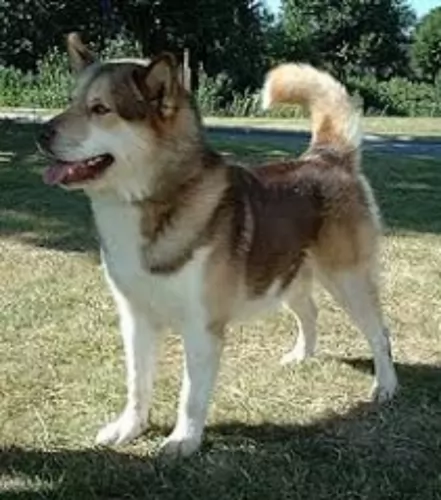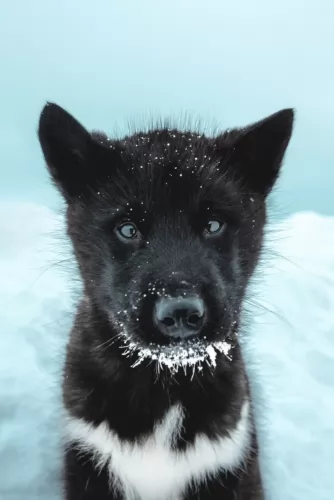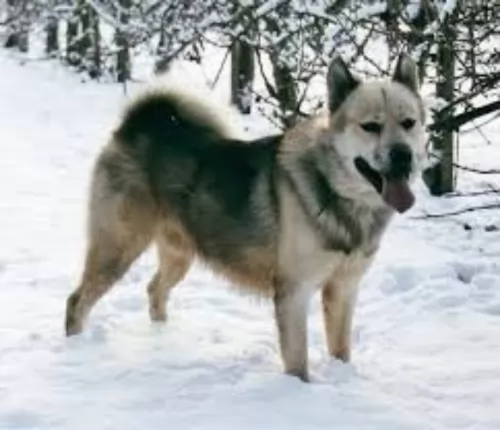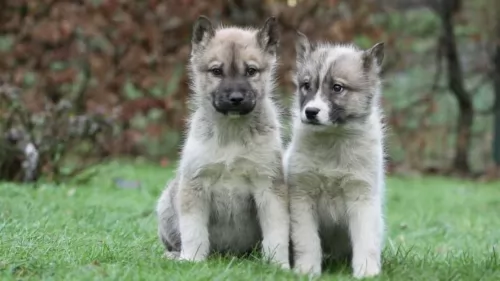 Petzlover
Petzlover Flat-Coated Retriever is originated from United Kingdom but Greenland Dog is originated from Greenland. Flat-Coated Retriever may grow 7 cm / 2 inches shorter than Greenland Dog. Both Flat-Coated Retriever and Greenland Dog are having almost same weight. Flat-Coated Retriever may live 3 years less than Greenland Dog. Both Flat-Coated Retriever and Greenland Dog has almost same litter size. Both Flat-Coated Retriever and Greenland Dog requires Moderate Maintenance.
Flat-Coated Retriever is originated from United Kingdom but Greenland Dog is originated from Greenland. Flat-Coated Retriever may grow 7 cm / 2 inches shorter than Greenland Dog. Both Flat-Coated Retriever and Greenland Dog are having almost same weight. Flat-Coated Retriever may live 3 years less than Greenland Dog. Both Flat-Coated Retriever and Greenland Dog has almost same litter size. Both Flat-Coated Retriever and Greenland Dog requires Moderate Maintenance.
 The Flat-Coated Retriever traces its heritage to 19th century England. A popular gamekeepers’ dog, the actual descendants of the breed are not entirely known. Like so many well-established breeds, there are many lines of thought about the breed line. There is an unverified line of ancestry that includes the St. Johns Water Dog – an extinct breed from North America. Another story has Canadian sailors bringing their Newfoundlands to England and mixing them with Colliers and Setters. This story has more truth to it and it took 20 years to establish the final breed type.
The Flat-Coated Retriever traces its heritage to 19th century England. A popular gamekeepers’ dog, the actual descendants of the breed are not entirely known. Like so many well-established breeds, there are many lines of thought about the breed line. There is an unverified line of ancestry that includes the St. Johns Water Dog – an extinct breed from North America. Another story has Canadian sailors bringing their Newfoundlands to England and mixing them with Colliers and Setters. This story has more truth to it and it took 20 years to establish the final breed type.
The breed was originally a retriever with two purposes – to retrieve the hunters’ bounty on land and on water.
The Flat-Coated Retriever was then introduced to the United States as a gun dog. By 1873 it was a “stable type” and in 1915 the AKC recognized the breed. After this, their popularity grew quickly until the American public fell in love with the Golden Retriever and the Labrador Retriever. Then the Flat-Coated Retriever’s numbers and popularity fell. The irony was that both the Golden and the Labrador credited the Flat-Coated Retriever as an ancestor. The survival of the breed was questionable following World War Two. They were brought back by a specific breeding program in the 1960’s.
Breeders in the ‘60s made sure they bred for both show dogs and companion animals. The Flat-Coated Retriever survived and is less popular than other retrievers, but he has his fans. The breed is more popular in the United Kingdom than it is in the United States in part because of Best in Show wins at Crufts
 The Greenland dog is an ancient breed of dog hailing from Greenland. The dog was brought to North American from Siberia hundreds of years ago. In fact the very first dogs arrived in the Americas some 12,000 years ago.
The Greenland dog is an ancient breed of dog hailing from Greenland. The dog was brought to North American from Siberia hundreds of years ago. In fact the very first dogs arrived in the Americas some 12,000 years ago.
The Greenland Dog isn’t recognized by the AKC but it is recognized by a number of other groups. While the Greenland Dog is valued in Greenland, it isn't particularly well known in other parts of the world.
 The Flat-Coated Retriever has a straight and strong topline with unique head, strong jaws, a long muzzle and small ears. His eyes are dark brown almonds with a friendly and intelligent expression. He has an arched neck and a moderately long tail. The Flat-Coated Retriever is more of an athlete, lighter and certainly more elegant than any other type or breed of retriever.
The Flat-Coated Retriever has a straight and strong topline with unique head, strong jaws, a long muzzle and small ears. His eyes are dark brown almonds with a friendly and intelligent expression. He has an arched neck and a moderately long tail. The Flat-Coated Retriever is more of an athlete, lighter and certainly more elegant than any other type or breed of retriever.
 The Greenland Dog is a heavily built dog, and between the males and females, this medium to large sized dog can be 51 – 68cm in height and weigh 30 – 35kg.
The Greenland Dog is a heavily built dog, and between the males and females, this medium to large sized dog can be 51 – 68cm in height and weigh 30 – 35kg.
He has the typical slanted eyes of the husky-type dogs with a keen, alert expression in them. He has small triangular erect ears. The long, bushy tail of the dog is curled over the back of the dog.
The coat is short to medium length and has 2 layers with the outer layer being fairly coarse. The double coat is thick and shortish but also stand-offish, meaning the hair doesn’t lie flat against the dog’s body. Color of the fur is a mix of cream, beige, white, tan, black, grey or silver.
As a working dog, the Greenland Dog is known for its strength, its boisterous nature and speed. Because its a dog that has worked as a pack, it wants a firm, patient, fair, confident owner to bring out the best in him. Being intelligent, independent and work-orientated, it is perhaps not a great choice for the first-time dog owner who may be out of their realm with the demands of these high-energy dogs.
The dog is independent, but he is quite capable of forming a strong, loving bond with his owner. This is certainly a dog that is never going to thrive if he has to lie around the house all day – he is an active dog who wants a task to do and he is going to need plenty of daily exercise.
They’ve always had active lives pulling sleds or hunting for seals and he craves this busy, active lifestyle. He is the kind of dog that shouldn’t live in the city with a tiny garden unless he has an owner who takes time to walk him and exercise him vigorously. He is a dog that will require training and socialization.
 The Flat-Coated Retriever is great with children. Just be careful they don’t knock over small children in their enthusiasm.
The Flat-Coated Retriever is great with children. Just be careful they don’t knock over small children in their enthusiasm.
They are confident great family dogs. They are “thinking dogs” and need something to work for or they will work for themselves. They can be clowns.
They are adaptable although their size might preclude small locations without yards.
Smart, thinking all the time, they are very trainable. However, they are considered the “Peter Pan” of dogs – they never grow up.
 Bred as a working dog, the Greenland Dog, native to Greenland is a high energy dog who is boisterous, lively and social. With training and socialization, he becomes an obedient, loyal and devoted pet.
Bred as a working dog, the Greenland Dog, native to Greenland is a high energy dog who is boisterous, lively and social. With training and socialization, he becomes an obedient, loyal and devoted pet.
While he is quite capable of being an awesome domesticated pet, he is essentially a working dog, loving having to be part of a very active lifestyle. He may not be the best pet for a first time owner or a home with small children. This is because he isn't your cuddly, lying-around-the-house, playmate kind of pet. He wants a home and owner similar to himself – strong, active, energetic, bold, independent, strong-willed and firm, and when he gets this, he becomes the splendid pet he is so well known for.
 Flat-Coated Retrievers have their share of health concerns from dysplasia to cancer. The breeds problems include:
Flat-Coated Retrievers have their share of health concerns from dysplasia to cancer. The breeds problems include:
Hemangiosarcoma, Osteosarcoma, Malignant Histiocytosis, and Fibrosarcoma. Studies show that about half of all Flat-Coated Retrievers die of cancer.
 Your Greenland dog can battle with eye problems such as progressive retinal atrophy, hereditary or juvenile cataracts and corneal dystrophy. Eye diseases like this can cause a host of problems for your pet and should receive immediate veterinary attention.
Your Greenland dog can battle with eye problems such as progressive retinal atrophy, hereditary or juvenile cataracts and corneal dystrophy. Eye diseases like this can cause a host of problems for your pet and should receive immediate veterinary attention.
Cataracts in dogs are a common problem affecting the eyes of dogs, with there being different forms and causes.The age at which your pet develops cataracts is important for identifying the type of cataract it is because it will give the vet an idea if the cataracts are an hereditary trait in certain dog breeds.
Nearly every dog can battle with hip dysplasia and it can be a serious concern for active canines such as the Greenland dog.
This joint and bone ailment can start manifesting itself as early as 4 months of age with your pet. This dysplasia occurs when the head of the femur doesn't fit into the pelvic joint the way it should. It can lead to pain, arthritis and lameness with your dog.
 He will be a medium size dog. Feed puppies 3-4 times a day about a 1/8 cup of high-quality food. Feed a puppy food designed for medium size dogs or specifically for retrievers.
He will be a medium size dog. Feed puppies 3-4 times a day about a 1/8 cup of high-quality food. Feed a puppy food designed for medium size dogs or specifically for retrievers.
Feed 2 times a day about !/2 cups of dry food per meal. Do not overfeed. They have a tendency to be obese.
Maintain a healthy weight and avoid exercise before and after meals. The good news is dysplasia and epilepsy are rare in the breed.
They are very energetic and need good exercise. Long walks and a yard to run in. Remember they are hunting dogs and will chase to retrieve things so don’t let them off leash outside your yard. They will excel at agility, tracking. Rally, obedience, swimming, hunting, and jogging. They make great therapy dogs.
 As a medium- to large-sized dog breed, the Greenland Dog will require a high-quality commercial dog food if that is what you will be feeding him. The top quality brands have the right mix of vitamins and minerals in them for health.
As a medium- to large-sized dog breed, the Greenland Dog will require a high-quality commercial dog food if that is what you will be feeding him. The top quality brands have the right mix of vitamins and minerals in them for health.
However, it is wise to ensure that such an active dog breed gets his quota of raw meat in too. He has been used to eating fish and seal meat and will require this raw diet too. Sometimes if you cook rice, chicken and vegetables, you can add this into his kibble too.
Greenland Dogs need to be groomed at least twice a week to keep the thick coat in tip top condition. He sheds throughout the year.
He will also require you brushing his teeth to get rid of plaque which can cause a host of health issues. You get special toothpaste and toothbrush for dogs. His teeth should be brushed 2 or 3 times a week.
Make sure you give your high-energy Greenland Dog the right dose of exercise. He is intelligent too so he needs walks, games and other activities that contribute towards his physical and mental wellbeing.
He will do well on large properties or farms but won't do well where the space is tiny and where the owners are inactive couch potatoes.
Be careful too that the Greenland Dog isn't exercised immediately after eating as this puts him in danger of developing bloat.